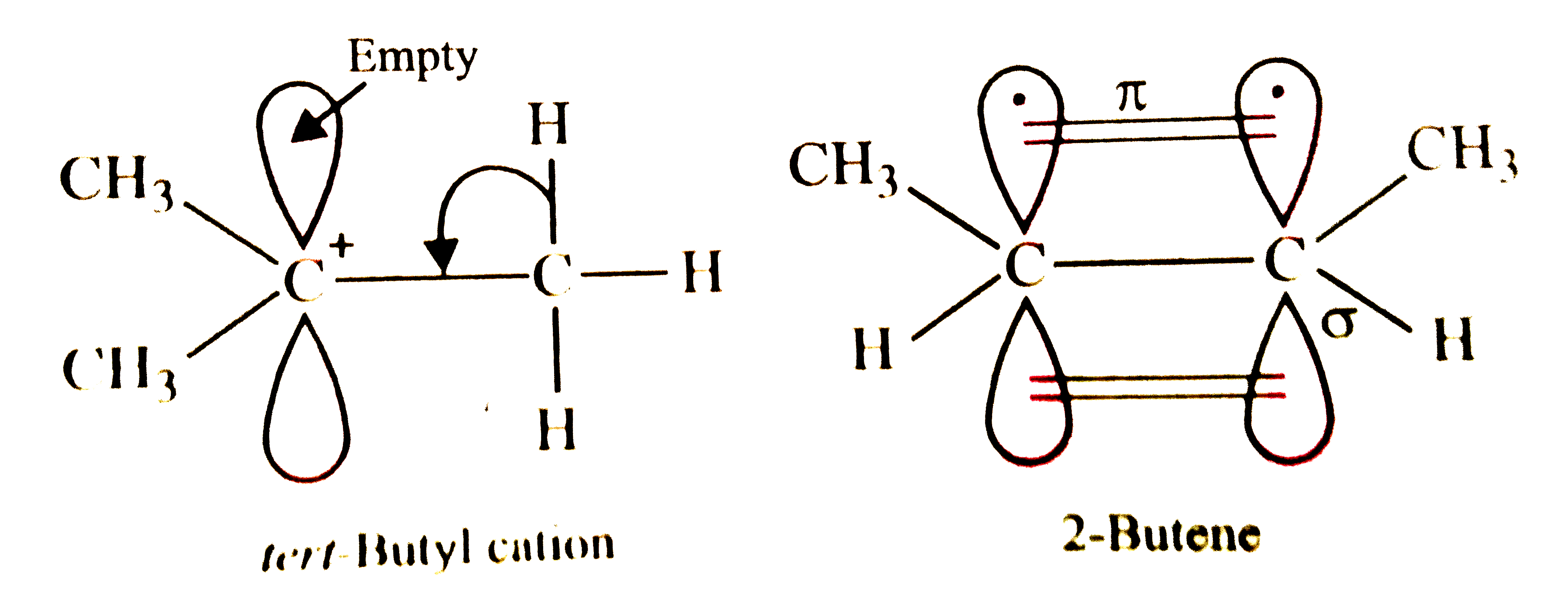The hyperconjugative stabilities of tert-butyl cation and 2-butene, respectively, are due to
A
σ−p (empty) and σ−π∗ electron delocalisations
B
σ−σ∗ and σ−π∗ electron delocalisations
C
σ−p (filled) and σ−π electron delocalisations
D
p (filled) →σ∗ and σ−π∗ electron delocalisations
Video Solution
Text Solution
The correct Answer is:A
In tert-butyl cation, the carbon bearing positive charge has an empty p-orbital and hence hyperconjugation here involves σ-p (empty) electron delocalisation.

In 2-butene, π-bond contains two electrons, one electron from each of the two carbon atoms, i.e., π-MO contains a pair of electrons, but π∗ MO is empty and hence electrons of the σ C-H bond can move only into the π∗ orbital. Thus, option (a) is correct.
|
Updated on:21/07/2023
Topper's Solved these Questions
- BOOK - PRADEEPCHAPTER - ORGANIC CHEMISTRY-SOME BASIC PRINCIPLES TECHNIQUESEXERCISE - Competition Focus (Jee (Main and Advanced)/Medical Entrance) II. Multiple Choice Questions (with one or more than one correct answers)8videos
ORGANIC CHEMISTRY-SOME BASIC PRINCIPLES TECHNIQUES
- BOOK - PRADEEPCHAPTER - ORGANIC CHEMISTRY-SOME BASIC PRINCIPLES TECHNIQUESEXERCISE - Competition Focus (Jee (Main and Advanced)/Medical Entrance) III. Multiple Choice Questions (Comprehension)12videos
ORGANIC CHEMISTRY-SOME BASIC PRINCIPLES TECHNIQUES
- BOOK - PRADEEPCHAPTER - ORGANIC CHEMISTRY-SOME BASIC PRINCIPLES TECHNIQUESEXERCISE - Analytical Questions and Problems with Answers/Solutions (Problems)4videos
ORGANIC CHEMISTRY-SOME BASIC PRINCIPLES TECHNIQUES
- BOOK - PRADEEPCHAPTER - HYDROGEN EXERCISE - COMPETITION FOCUS (Assertion-Reason Type Questions) Type 215videos
HYDROGEN
- BOOK - PRADEEPCHAPTER - P-BLOCK ELEMENTS (NITROGEN FAMILY)EXERCISE - Competition focus jee(main and advanced)/ medical entrance special) (VIII. Assertion-Reason Type Questions)10videos
P-BLOCK ELEMENTS (NITROGEN FAMILY)
Similar Questions
Knowledge Check
- Question 1 - Select One
The hyperconjugative stabilities of tert-butyl cation and 2-butane, respectively, are due to
Aσ to p(empty) and σ to π∗ electron delocalisationsBσ to σ∗ and σ to π electron delocalisationsCσ to p (filled) and σ to π electron delocalisationsDp(filled) to σ∗ and σ to π∗ electron delocalisations - Question 2 - Select One
The hyparconjugative stabilities of tert-butyl cation and 2-butene, respectively ,are due to
Aσ→p(sigma)(empty )andσ→π*electron delocalization.Bσ→σ*andσ→π electron delocalization.Cσ→p (filled ) and σ→π electron delocalization.Dp (filled ) →σ*andσ→π* electron delocalization . - Question 3 - Select One or More
The greater stability of tert-butyl carbocation than methyl carbocation can be explained on the basis of
A+I effect of the methyl groupsBelectromeric effect of the methyl groupsChyperconjugation effect of the methyl groupsD−I effect of the methyl groups.
Tert - butyl chloride is
View SolutionThe IUPAC name of tert-butyl chloride is
View SolutionIsovalent hyperconjugation explanis the stability of
View SolutionCarbonium ion of tert. butyl bromide is
View Solution(A) tert-Butyl methyl ether on cleavage with HI at 373K gives tert-butyl iodide and methanol.
(R ) The reaction occurs by SN2 mechanism.View Solution

